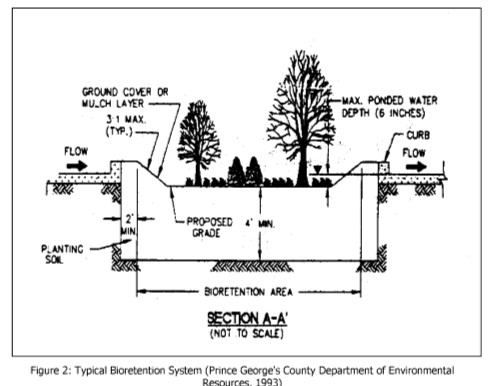RAIN GARDENS & BIORETENTION CELLS
Low Impact Designs are a wonderful tool to filter and slow stormwater runoff in both urban and rural spaces. One design element that can be used in both large and small spaces are rain gardens and bioretention cells. These designated areas are shallow depressions planted with vegetation that filter and infiltrate runoff. It mimics natural drainage by slowing down water, allowing sediment and pollutants to settle, and using soil and plant roots to clean the water before it infiltrates into the ground or flows into nearby waterways.
There are a number of factors that need to be taken into consideration when locating a spot for rain gardens - like soil permeability and slope of landscape. Urban areas need to consider curb run off and should discuss with their municipalities before building. Bioretention cells are best filtering first flush run off and used to remove pollutants from water. They can be used to help clean water from residential structures and cities may need extra involvement to design roadways to use Low Impact Design strategies as an extra layer of cleaning water from street runoff before heading into water processing plants.
When deciding where to place a rain garden, keep in mind how stormwater flows over the site.
SITE DESIGN
There are six common components to a Bioretention Cell:
Grass buffer strip | slows runoff velocity and begins filtering
Sand bed | provides aeration and drainage while flushing pollutants
Ponding area | provides storage runoff for settlement of sediment
Organic layer | filters pollutant and reduces soil erosion
Planting soil | creates space for runoff uptake
Plants | finishes the process of the water cycle and pollutant removal
These areas can be combined with other stormwater management strategies. Design best practices suggest that these areas take up approximately 5-7% of the drainage basin to get the best results for the cost of the design.
Maintenance should also be considered and depending on the scenario, most likely need to be addressed every 5-10 years by clearing out unneeded sediment and dead/diseased vegetation while replacing good soils and mulching. The mulching itself should be a couple inches thick and replaced every year for the health of the system. Native plants should be chosen to reduce risk of an invasive system taking over. Maintenance should include a yearly sweep for invasive removal.
There are a few reasons as to why Mane Cultivation would look into bioretention basins on our site. With having so much of our soil as sand, this will give us opportunities to make small areas to manage stormwater before percolation. We will be able to create microclimates to support ourselves and native vegetation, which will blend into the natural topography and waterways of the Big Sandy basin.
FREQUENTLY ASKED QUESTIONS (FAQ)
What are the benefits of rain gardens and bioretention cells?
They improve water quality through filtration and reduce on site flooding.
Where should bioretention cells be placed in a design?
Use as a first flush system. Keep approximately 10’ from building foundations and consider buffer areas and 3:1 slope to reduce erosion from overflow.
Can bioretention be used with other water management strategies?
Yes, multiple strategies can be used together for stormwater management based on individual site requirements.




